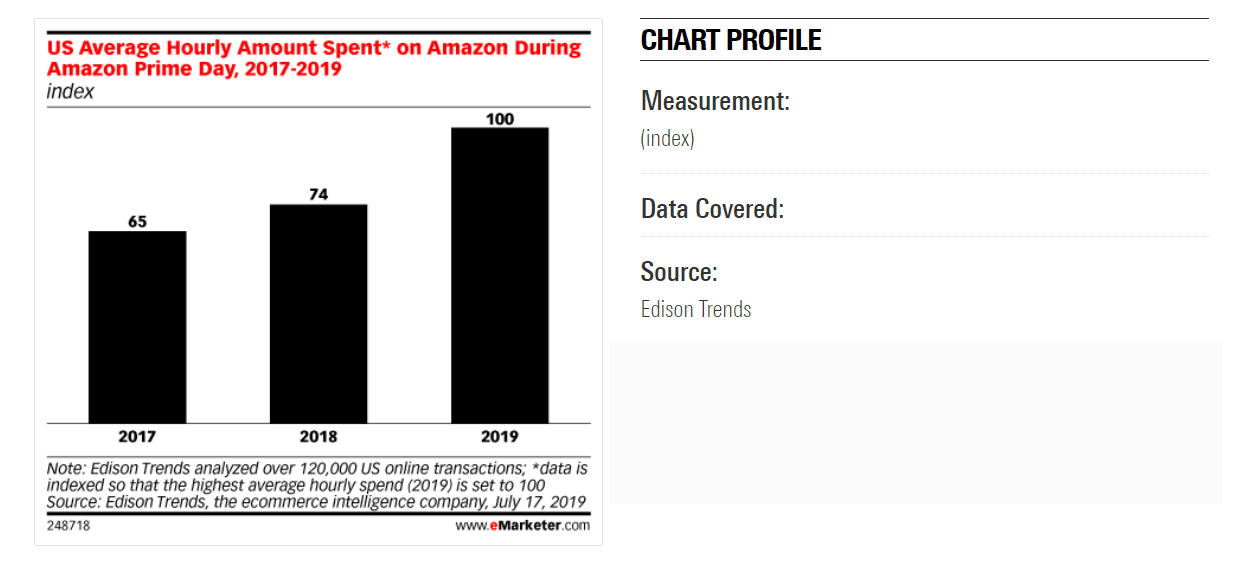What’s the biggest shopping event of the year? While Cyber Monday and Black Friday generate more consumer spending in general, it’s hard to argue with the fact that a single company—Amazon—has created its own shopping holiday worth an estimated $7.16 billion seemingly out of thin air.
Well, not exactly thin air: Amazon recognized that people wait until Black Friday to make high-end purchases for themselves, such as TVs, furniture, and other electronics.
Amazon’s Christmas in July is quite a sight to behold—but what can we learn from it? How can you use the strategies Amazon has developed to market your brand?
In this post, we put together plenty of email marketing examples from Amazon’s automated Prime Day campaigns this year so you can draw inspiration going into the holiday spending season.
Consumers outspend both Black Friday and Cyber Monday on Christmas in July
Before we jump into some examples and strategy ideas, let’s take a look at the facts.
Amazon generates more money on Prime Day than Black Friday or Cyber Monday.
In 2016, Prime Day sales surpassed Cyber Monday by 19%. By 2017, that figure had increased to 33%. In 2018, Amazon customers purchased 3x more products during on Christmas in July compared to Black Friday.
Why? Well, for one thing, 70% of the Prime Day deals are often much better than those available on Black Friday.
For another, people are gravitating toward online shopping. Cyber Monday continues to outperform Black Friday in terms of USD spent because people are increasingly shopping on phones and laptops instead of brick-and-mortar stores.
Source: EMarketer
What can Prime Day teach us about Black Friday 2019?
From their cutting-edge personalized experiences and pleasant browsing experience to speedy shipping and comprehensive membership program, there’s no question that Amazon is defining the online shopping path and setting standards.
You probably can’t position your brand as a direct competitor to Amazon—but you don’t have to. Instead, take inspiration from Amazon’s — completely automated—email marketing strategy to prepare your store for Black Friday 2019 and next year’s Christmas in July.
Personalization is necessary.
At this point, only about 39% of online retailers have taken Amazon’s lead and started sending personalized email campaigns. In 2019 and beyond, personalized content is crucial—your customers expect it.
According to Adobe research, 67% of customers expect brands to provide a personalized experience online and nearly half get frustrated when brands only offer generic promotions that don’t relate to them personally.
Back to its days as an online bookstore, Amazon always understood the value of a customized experience for each visitor with “customers also bought” recommendations.

Optimize every pixel of space.
Headings, footers, buttons—Amazon doesn’t let one pixel of space go to waste.
Leading up to Prime Day, Amazon included a special header image in all of their general promotional emails subtly reminding shoppers that Prime Day was coming up.
It may be a good idea to add similar promotional headers to your transactional emails which have 8x higher open rates than other campaigns.

Highlight your membership and rewards programs to build exclusivity.
With Amazon Lockers sprouting up and the retail giant expanding accessibility, it also needs to find new ways for its Prime members to feel special.
Leading up to Prime Day, Amazon grants special early bird access to unique deals for Prime members.
For Black Friday and Cyber Monday, look for new ways to build customer loyalty with membership programs and your most-engaged subscribers.
The Prime Insider guide provides a slew of events, deals, and tips for making the most out of Christmas in July and it’s only sent out to Prime members.

Promote your app and schedule push notifications.
With Amazon, push notifications and automated email campaigns go hand-in-hand.
Amazon doesn’t overwhelm users with app push notifications, instead they just nudge the user to open the app and start browsing by reminding them that it is, in fact, Prime Day.
For Black Friday and Cyber Monday, spend some time throughout August, September, and October promoting your brand’s app in widgets and footers of your email campaigns.
Let subscribers know what benefits they can enjoy by installing the app and how they can use it to connect with your brand for a seamless experience.
Consumers buy for themselves, too.
Yes, Black Friday and Cyber Monday are about buying gifts but let’s be honest: People use them to shop for themselves.
Take a look at all the Prime emails in this post. While many of them do contain promotions for Amazon’s electronics and smart home devices, they also contain plenty of totally mundane everyday items like laundry detergent, bedsheets, and groceries.
Personalization here is especially important so you can provide your subscribers with the perfect mix of gift suggestions and everyday items for themselves.
Christmas in July boosts online shopping across the entire internet—not just with Amazon. Entrepreneur took advantage of this with a Prime newsletter of its own:

Use newsletters to build authority and anticipation.
Leading up to Prime Day, Amazon sent out plenty of newsletters to build anticipation.
Each newsletter contained a combination of popular videos, events, personalized product recommendations, virtual subscription deals, interactive widgets to build shopping lists, and much more.
Newsletters are valuable for demonstrating authority with informational, entertaining, and helpful content. It’s also not a bad idea to offer interactive content in your emails like Amazon’s shopping list feature here or calendars.

Giveaways aren’t dead.
Marketing trends may fall in and out of style as frequently as memes but one thing remains the same: people appreciate free stuff.
Amazon knows this. On Prime Day, Amazon sent out an email letting subscribers know that they could claim a free photo product.
If customers had no intention of shopping on Christmas in July, this free product encouraged them to at least open the app to claim the offer. Once they opened the app and started checking out the deals, do you think they added more products to their cart? Maybe!
Free products are perfect for marketing both e-commerce and storefront retailers. If you have a brick-and-mortar shop, you can turn Black Friday into an event worthy of getting off the couch with entertainment, prizes, free samples, and more—and use email to build the hype for it.

Keep it simple.
Simplicity goes a long way in marketing.
An aesthetically pleasing image, bright button, and line or two of text is all you need in some cases to get subscribers over to your website.
These emails work because they’re not overly promotional or salesy: You’re simply asking them to visit a website or landing page. Once they get there, making a purchase and deciding what to browse is completely in their control.

Feedback matters.
Consider this for a second: Amazon shouldn’t have to care about customer feedback. They’re the largest online retailer in the world and dominate entire industries.
But amazon does care about customer service—very much so.
For every single product purchased on Amazon, the customer gets an automated follow-up email asking for a review.
For Prime Day, Amazon took it a step further. Every Prime member got an automated email after the shopping extravaganza ended asking them to fill out a survey about the app, website, and general shopping experience of the holiday.
Here’s where segmentation gets important. After Black Friday, break your subscriber list up into two groups: customers who made a purchase and subscribers who didn’t.
Send feedback emails to both groups, but personalize them. For customers who made a purchase, thank them and ask them how you did. For customers who didn’t, ask how you could improve and earn their business.

Strategize with brick-and-mortar stores.
Over the past few years, you may have noticed something new inside your local Whole Foods or Rite Aid: Amazon Lockers.
Amazon has made it easier for non-Prime members to enjoy the speedy shipping of a Prime membership. Instead of paying for a membership, shoppers can make a purchase through the Amazon website and select the nearest storage locker to pick up their merchandise.
Depending on your brand’s industry, it may be worth highlighting a similar service during the holiday season—such as making a purchase online and picking it up at the store.
Many consumers also appreciate making returns at a local store (or Amazon Locker) instead of shipping items back through a post office.
Wrap up
Consumers keep trending towards laptop and mobile shopping—and this trend isn’t going away. Instead of fighting against it and shaking your fist at Amazon, adapt some of the online giant’s marketing tactics.
- Personalization is basically mandatory.
- People appreciate membership programs and giveaways.
- Automation can make your work easier and more effective.
- Create a mobile-friendly experience either through a branded app or optimized landing pages.
By following in the footsteps of Prime Day, you can provide your customers and subscribers with the digital experience they’ve come to expect, due to Amazon’s role as a leader.
Start planning your Black Friday and Cyber Monday strategies now. Discover everything you need to know about strategizing your holiday email campaigns.






